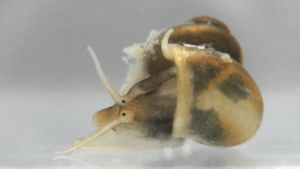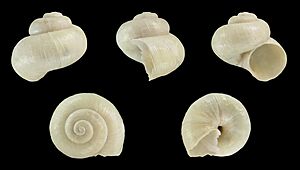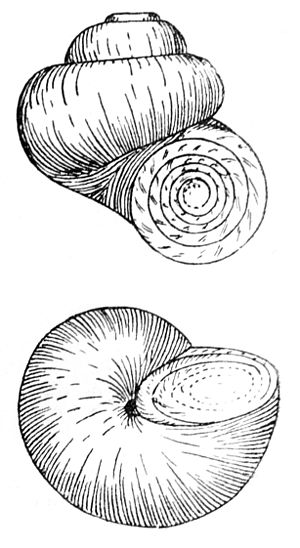Valvata piscinalis facts for kids
Quick facts for kids Valvata piscinalis |
|
|---|---|
 |
|
| a live Valvata piscinalis | |
| Conservation status | |
| Scientific classification |
The Valvata piscinalis, also known as the European stream valvata or European valve snail, is a tiny freshwater snail. It lives in water and belongs to a group of animals called mollusks, just like clams and squids. This snail has gills to breathe underwater and a special "door" called an operculum that can close its shell opening. It's part of the Valvatidae family, which are often called valve snails. Sometimes, it's also called Cincinna piscinalis.
Contents
Different Types of Valvata piscinalis
There are several types, or subspecies, of Valvata piscinalis. These are like different versions of the same snail.
- Valvata piscinalis piscinalis
- Valvata piscinalis antiqua
- Valvata piscinalis geyeri (named after a German zoologist, David Geyer)
- Valvata piscinalis discors
- Valvata piscinalis alpestris
What the Shell Looks Like
The shell of the Valvata piscinalis has a slightly squeezed opening. The top part, called the spire, can be taller in water with more nutrients. These shells usually have four or five turns, called whorls. They are white to light brown, with more orange or red color at the very top. The "door" (operculum) that closes the shell has spiral patterns, like a tiny swirl.
It can be tricky to tell the European valve snail apart from another snail, Valvata sincera, which lives in the Great Lakes in North America. The North American snail has a rounder opening and a wider belly button-like hole (called an umbilicus). Its shell also has rougher growth lines.
In the Great Lakes, adult European valve snails are about 5 mm tall and 3–5 mm wide. In Europe, they can grow a bit larger, up to 7 mm tall and 6.5 mm wide, but they are usually smaller.
Here are some typical sizes for different types of the snail:
- Valvata piscinalis piscinalis: 4–5 mm wide, 3-4.5 mm high.
- Valvata piscinalis antiqua: 4.5 mm wide, 6 mm high.
- Valvata piscinalis geyeri: 2.5 mm wide, 3 mm high.
- Valvata piscinalis discors: 3 mm wide, 3 mm high.
- Valvata piscinalis alpestris: 6.3 mm wide, 5.5 mm high.
Snail Anatomy
These snails are usually yellow with grey and white spots. They have darker spots on their snout and the soft skin that covers their body (mantle). They have blue eyes at the bottom of their long tentacles. When the snail moves, you can see a special breathing organ called a ctenidium sticking out.
Where Valvata piscinalis Lives
The Valvata piscinalis is found across a large area called the Palearctic region. This includes Europe and parts of Asia.
Even though this snail is common in some places where it has been introduced (like North America), its numbers have gone down in some parts of its native home. In some areas, it is even considered endangered.
Native Homes
This snail naturally lives in the British Isles and all across Europe, reaching as far as Asia Minor and even Tibet. It is very common in many freshwater places in Europe, the Caucasus region, western Siberia, and Central Asia. However, you won't find it in Iceland.
In Europe, it lives in countries like:
- Austria
- Croatia
- Czech Republic
- Slovakia
- Poland
- Germany (its status varies by region)
- Netherlands
- The British Isles: Great Britain and Ireland
- Sweden
In Asia, it has been found in:
- India
New Homes (Introduced Areas)
Valvata piscinalis is not native to the United States. It was first brought to Lake Ontario in 1897. Over the next 40 years, it spread to Lake Erie and then to other rivers and lakes. These include the Saint Lawrence River, the Hudson River, Champlain Lake, and Cayuga Lake. More recently, in the 1990s and early 2000s, it was found in Lake Superior, Lake Michigan, and Oneida Lake in New York State.
How Valvata piscinalis Lives
Habitat
This small snail lives in freshwater streams, rivers, and lakes. It prefers water that is moving and can live in water with low levels of calcium.
In its native areas, you often find this snail in clear water, especially in lakes with few plants or those with specific types of plants like Chara and Potamogeton. It likes muddy, silty, or sandy bottoms, especially when it's hibernating. It also likes to lay its eggs on water plants.
The snail can survive even if many water plants disappear. It has been found in ponds where almost all the plants were gone. In the Great Lakes, these snails can live at depths from 0.5 meters to 23 meters. In Europe, they are usually found in water up to 10 meters deep.
Valvata piscinalis can handle different amounts of calcium in the water. It also doesn't need very warm temperatures to survive. These snails can spend the winter buried in mud and even grow during this cold time. They can also handle a little bit of salt in the water, up to 0.2%. This helps them live in places like the Curonian Lagoon, where salty water sometimes comes in for a few hours or days.
Feeding Habits
This snail is a good eater. It scrapes off and eats tiny algae that grow on surfaces, and also eats detritus (dead bits of plants and animals). In water with more nutrients, it can also filter tiny bits of food and algae from the water. Valvata piscinalis can even scrape off small pieces of water plants to eat.
Life Cycle
Valvata piscinalis grows quickly and has many babies. Each snail is a hermaphrodite, meaning it has both male and female parts. When they reproduce, one snail acts as the male and the other as the female. Their babies do not have a free-swimming larval stage.
A snail can lay eggs 2 or 3 times a year, with up to 150 eggs at a time. The eggs are laid on water plants. The eggs usually hatch in 15–30 days. Snails start reproducing when they are about 1 year old and usually live for 13–21 months. In Europe, they lay eggs from April to September, with breeding happening later in the year in colder, northern areas.
Parasites
Valvata piscinalis can be the first host for a type of worm called Echinoparyphium recurvatum. It can also be both the first and second host for another worm, Echinoparyphium mordwilokoi, in Europe.
It can also be a host for:
- Cyanthocotyle bushiensis
- Syngamus trachea
How Snails Avoid Danger
This snail can sense chemicals in the water. This helps it detect if leeches are nearby. It can even tell if a leech eats snails or not. If it senses danger, it can quickly close its operculum (the "door") to protect itself from being eaten.




